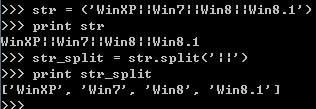【 Python进阶】python strip() split()函数实战
2017-07-29 17:42
721 查看
本文转载自:Python进阶---python
strip() split()函数实战
先看一个例子:
>>> ipaddr = 10.122.19.10File "", line 1
ipaddr = 10.122.19.10
^
SyntaxError: invalid syntax
>>> ipaddr = "10.122.19.10"
>>> ipaddr.strip()
'10.122.19.10'
>>> ipaddr = '10.122.19.10'
>>> ipaddr.strip()
'10.122.19.10'
>>> ipaddr.split('.')
['10', '122', '19', '10']
>>> ipaddr.strip().split('.')
['10', '122', '19', '10']
>>>
python strip()函数
介绍
函数原型声明:s为字符串,rm为要删除的字符序列
s.strip(rm) 删除s字符串中开头、结尾处,位于 rm删除序列的字符
s.lstrip(rm) 删除s字符串中开头处,位于 rm删除序列的字符
s.rstrip(rm) 删除s字符串中结尾处,位于 rm删除序列的字符
注意:
1. 当rm为空时,默认删除空白符(包括'\n', '\r', '\t', ' ')
例如:
复制代码 代码如下:
>>> a = ' 123'
>>> a.strip()
'123'
>>> a='\t\tabc'
'abc'
>>> a = 'sdff\r\n'
>>> a.strip()
'sdff'
2.这里的rm删除序列是只要边(开头或结尾)上的字符在删除序列内,就删除掉。
例如 :
复制代码 代码如下:
>>> a = '123abc'
>>> a.strip('21')
'3abc' 结果是一样的
>>> a.strip('12')
'3abc'
Python Split函数的用法总结(
字符串的split用法说明:
Python中没有字符类型的说法,只有字符串,这里所说的字符就是只包含一个字符的字符串!!!
这里这样写的原因只是为了方便理解,仅此而已。
1.按某一个字符分割,如‘.’
1 | str = ( 'www.google.com' ) |
2 | str |
3 | str_split = str .split( '.' ) |
4 | str_split |

2.按某一个字符分割,且分割n次。如按‘.’分割1次
1 | str = ( 'www.google.com' ) |
2 | str |
3 | str_split = str .split( '.' , 1 ) |
4 | str_split |

3.按某一字符串分割。如:‘||’
1 | str = ( 'WinXP||Win7||Win8||Win8.1' ) |
2 | str |
3 | str_split = str .split( '||' ) |
4 | str_split |

4.按某一字符串分割,且分割n次。如:按‘||’分割2次
1 | str = ( 'WinXP||Win7||Win8||Win8.1' ) |
2 | str |
3 | str_split = str .split( '||' , 2 ) |
4 | str_split |

5.按某一字符(或字符串)分割,且分割n次,并将分割的完成的字符串(或字符)赋给新的(n+1)个变量。(注:见开头说明)
如:按‘.’分割字符,且分割1次,并将分割后的字符串赋给2个变量str1,str2
1 | url = ( 'www.google.com' ) |
2 | str1, str2 = url.split( '.' , 1 ) |
3 | str1 |
4 | str2 |
缺图
一个正则匹配的例子:
>>> str="xxxxxxxxxxxx5 [50,0,50]>,xxxxxxxxxx"
>>> lst = str.split("[")[1].split("]")[0].split(",")
>>> print lst
['50', '0', '50']
分解如下
>>> list =str.split("[") 按照左边分割
>>> print list
['xxxxxxxxxxxx5 ', '50,0,50]>,xxxxxxxxxx']
>>> list =str.split("[")[1].split("]") 包含的再按右边分割
再对所要的字符串按照分割副 存放在列表中
>>> list
['50,0,50', '>,xxxxxxxxxx']
>>> str.split("[")[1].split("]")[0]
'50,0,50'
>>> str.split("[")[1].split("]")[0].split(",")
['50', '0', '50']
>>>
一个例子:判断输入的字符串是否为合法的IP
<img src="http://s8.sinaimg.cn/mw690/002ZKymTgy6JpBpoxYH27&690" width="690"
height="389" name="image_operate_99831401914041285" alt="python strip() split()函数 介绍" title="python strip() split()函数 介绍"
style="margin:0px; padding:0px; border:0px; list-style:none">
可以设计测试用例如下:
参考lhttp://www.51testing.com/html/55/n-212855.html
[root@akang python_practice]# python check_ip.py asdf
check ip address failed!
[root@akang python_practice]# python check_ip.py 10.12
check ip address failed!
[root@akang python_practice]# python check_ip.py !@#
-bash: !@#: event not found
[root@akang python_practice]# python check_ip.py a.s.d.f
check ip address failed!
[root@akang python_practice]# python check_ip.py 172.10.10.10
check ip address success!
[root@akang python_practice]# python check_ip.py 255.255.255.255
check ip address success!
[root@akang python_pract
相关文章推荐
- Python进阶---python strip() split()函数实战(转)
- Python进阶---python strip() split()函数实战
- Python学习笔记:split()函数和strip()函数的使用说明
- python strip() 函数和 split() 函数的详解及实例
- python字符串split()、join()、strip()函数的总结
- python学习——函数strip() 与 split()
- <python>strip() 函数和 split() 函数的理解
- Python常见字符串操作函数小结【split()、join()、strip()】
- 【Python】 strip(),split()函数介绍
- Python中strip() 函数和 split() 函数的理解
- python中strip() 函数和 split() 函数的理解
- python strip() split()函数
- python中strip() 函数和 split() 函数的理解
- python中strip() 函数和 split() 函数
- Python中strip()函数和split()函数详解
- <python>strip() 函数和 split() 函数的理解
- python strip() 函数和 split() 函数的详解及实例
- python中split()函数与strip()
- python strip() split()函数
- python strip() split()函数
